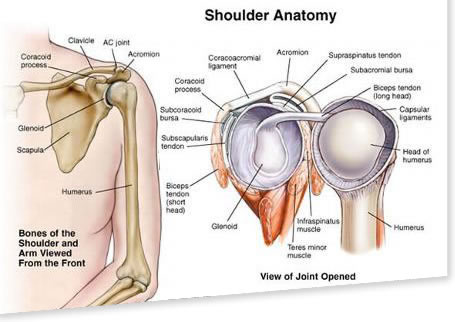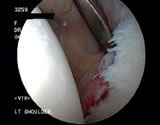Shoulder Dysfunction

Rotator Cuff injuries
The shoulder is a ball and socket joint. The relatively small area of contact between the joint surfaces allows for a large range of movement. To maintain stability the joint has to rely on diffuse ligament and muscle support. The four small muscles of the rotator cuff provide a stabilising action on the humeral head during strong contraction of larger muscles producing primary strong movements. These four muscles supraspinatus, infraspinatus, subscapularis and teres minor may be injured due to trauma, excessive loading of the joint and particularly during overhead activities. Injuries can cause complete or partial tears and fibrous thickening.
Frozen Shoulder
Many shoulder symptoms are described as Frozen shoulder. However misdiagnosis is common. True Frozen Shoulder is a capsular pathology and should be correctly termed Capsulitis. The joint capsule encloses the shoulder joint. It becomes infiltrated with white blood cells and inflammatory cells. Consequentially, the capsule becomes less flexible, joint motion is reduced and painful. Certain muscles shorten and become taught while others are stretched and weaken. There is concomitant contraction of connective fascial tissue.
It is possible in many cases, though not all, to correct muscle and fascial imbalance with techniques such as: specific muscle trigger point release, myofascial stretching and mobilisation and dry needling. Although capsular pathology can respond to manual treatment often it does not and may need to recover slowly. Differential assessment is essential to determine a case for treatment.
Impingement Syndrome
Injury to the shoulder joint can cause thickening under the acromion arch where the bursa or fluid sack can become inflamed. Bone spurs may also exist on the underside of the lateral acromion This limits the scope for normal joint function, inhibits movement and causes pain particularly when lifting the arm.
Tears of the shoulder cartilage

Labral damage in a shoulder joint - photo from an arthroscope
The cartilage which surrounds the glenoid cavity of the scapula, know as the labrum, can be torn in several places. These tears are due to stress on the joint during dynamic activities, especially overhead movements. With labral tears the shoulder feels unstable and more difficult to control. Stability is poorest when trying to throw.
A Bankart tear affects the anterior labrum -2-5 on the clock face. A reverse Bankart tear affects the posterior labrum. Instability is the main feature of this lesion.
A SLAP (superior labrum anterior/posterior) lesion affects the upper labrum-10-2 on the glenoid fossa. The long insertion of the biceps tendon attaches at the tip of the glenoid labrum. Symptoms of these tears are more subtle, biceps pain, clicking and a dead arm during throwing.
Consultations and Treatment from £95*
Appointments
07850 699534
*More complicated conditions may require
longer consultations and additional cost